D-11 rocket complex with a P-31 ballistic missile
The appearance of the D-11 / P-31 project was preceded by certain events in the highest circles of the naval command. At the very beginning of the seventies, it was decided that it was necessary to modernize the nuclear submarines of the 667A project, carrying the D-5 complex with the P-27 rocket. Such weapon the military was no longer fully satisfied, which required replacing it with a newer system with enhanced characteristics. At the same time, the replacement of weapons should not have had a major impact on the design of the boat carrier.
The Arsenal design bureau and SKB-385 (now the State Rocket Center) were involved in the preliminary elaboration of the new missile system. Arsenal employees proposed a system project with a solid-fuel rocket, while SKB-385 developed a product with liquid engines. The customer studied two technical proposals and made his decision. The development of Arsenal design bureau was considered more promising. Despite the existing negative experience in this area, the proposed solid-fuel rocket was of great interest.

Rocket P-31. Figure Militaryrussia.ru
10 June 1971 was issued by a decree of the USSR Council of Ministers, which was given a start to the new project. Engineers of KB "Arsenal" headed by P.A. Tyurin had to create a complex, which received the designation D-11, with a rocket called P-31. The employees of SKB-385 should have taken part in the new project. They were required to hand over to the organization D-11 the documentation for the unrealized project Р-27МТ. Also in the project were to participate several other organizations that were required to create certain elements of the new complex.
A promising missile system was designed to replace existing systems on modernized submarines, which led to the emergence of a number of characteristic requirements. The main requirement for the new rocket P-31 concerned dimensions. The dimensions of the silo launcher should have been maintained at the same level, which would have allowed dispensing with the unacceptably complicated rebuilding of the boats. However, the impossibility of increasing the dimensions of the product could have a negative impact on the firing range and other characteristics.
As a result of consultations with the customer, it was possible to adjust the technical task. Now it was necessary to keep only the diameter of the launcher, and its height could be increased within reasonable limits. Due to this innovation and a number of other ideas, it was possible to solve the problem of locating all the required aggregates and achieving the required firing range. An additional result of the application of new ideas was a noticeable increase in the starting weight of the new rocket in comparison with the product being replaced. In addition, the start method was adjusted.
The P-31 rocket was proposed to be built in a two-stage scheme with a separate stage of breeding warheads. The assembled product had a cylindrical body with a drop head fairing of ogival shape, three belts of holding devices and a powder accumulator of pressure of small diameter. The head fairing for proper movement in water received a special device for creating a cavity, made in the form of two rings of a special configuration and equipped with a gas generator. The total length of the P-31 rocket was 11,06 m, the case diameter was 1,54 m. The launch weight was determined at the level of 26,84 t.
The product had a first stage with a total length of 6,3 m and a weight of 17355 kg. Almost the entire steel casing of the first stage was given to the placement of the engine 3D17. The engine case was filled with solid fuel, made in the form of a single-channel eight-slot unit. In the manufacture of the rocket, fuel in molten form was proposed to be poured into the body. The design of the latter provided a strong retention of the solidified charge. Fuel first stage weighed 15,76 t.
On the tail bottom of the body of the first stage were placed four nozzles of a split design. With their help, it was proposed to create a craving, as well as to control the direction of the rocket flight. The swinging parts of the nozzles were equipped with an electro-hydraulic drive and received compensators based on levers and springs. The first-stage engine used developed traction up to 59 and worked with 84.
The second stage was a cylindrical unit with a smaller solid-fuel engine. The length of the second stage was 3 m, the mass - 6,86 t. The body of the second stage was proposed to be made of plastics. Like some of the previous models of rockets, the second stage of the P-31 received the engine of the recessed layout. In order to reduce the product length, the second stage engine nozzle was partially placed inside the combustion chamber.
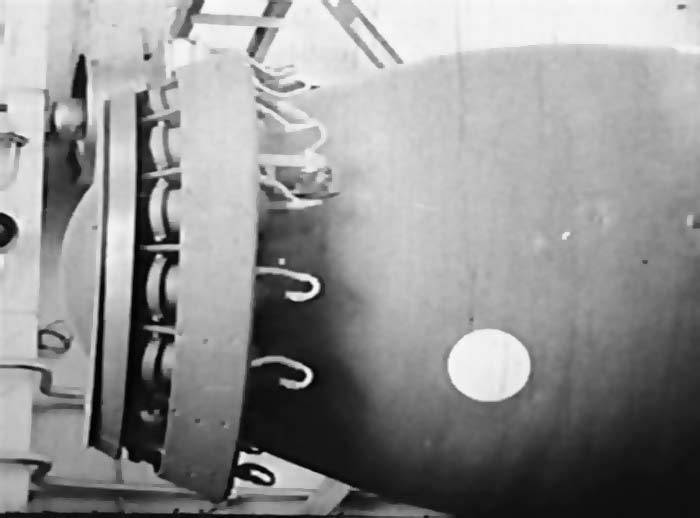
The head of the rocket with the device of the formation of the cavity. Photo Militaryrussia.ru
The second stage engine was equipped with a single-channel 26-slit charge of solid fuel of mass 6,28 t. It was proposed to use the same fuel as in the first-stage engine with a similar charge mount to the body. The engine of the second stage had one nozzle on the cardan installation, which allowed to carry out control by pitch and yaw. For roll control, it was proposed to use two small-sized solid-fuel low-thrust engines. The second stage propulsion engine had to develop thrust to 23,8 t and work up to 75 s.
The breeding stage was made in the form of a platform with a set of necessary equipment, its own engines and fixtures for the payload. It was equipped with four solid fuel engines for 60 kg with the ability to rotate the nozzles. The task of the breeding stage was to change the flight path before dropping warheads.
For the P-31 rocket, an autonomous guidance system based on inertial navigation was developed. Automatics had to monitor the flight parameters of the rocket and keep it on the desired trajectory. In view of the use of solidsless solid fuel engines, the main task of targeting warheads was assigned to the step of guidance. After separation from the second stage, this product was supposed to lead warheads to the desired trajectory, thereby determining the firing range and direction of their flight.
Initially, three variants of the warhead were designed for the new ballistic missile. The first version used a special warhead with a power of 500 kt and a weight of 450 kg. The second version of the warhead carried three charges of individual guidance with a total weight of 720 kg. In the third case, eight warheads with a total weight of 1120 kg were proposed. In all variants, the warheads were equipped with low-power spin engines. After separation from the dilution stage, this device should have given the warhead rotation around the longitudinal axis, which led to flight stabilization and a certain improvement in pointing accuracy.
To launch a rocket, it was proposed to use a powder pressure accumulator and a cavity formation unit. The first was a cylindrical block with curved lids mounted on the tail end of the rocket. 180-kg charge of solid fuel, similar to that used by engines, was placed inside the case with holes on the side surface. During the launch, the charge was supposed to burn and form gases, pushing the rocket out of the launcher.
It was proposed to install a block of two special-profile rings and a gas generator on the P-31 missile fairing. When a rocket hit the water, these rings had to change the flow around the body, and the task of the gas generator was to form a large gas cavity around the product. This reduced the negative impact of the environment on the rocket, and also simplified its output to the surface.
A prospective ballistic missile was to be used to destroy ground targets with previously known coordinates at ranges up to 4200 km. When firing at a maximum range, the circular permissible deviation did not exceed 1400 m, and was compensated for by the power of the warhead.
For the D-11 complex, an updated launcher was developed, differing from the D-5 system units with increased length. The diameter at the same time remained the same. The rocket was to be placed in the shaft and closed with a special membrane. Due to the maximum possible increase in the diameter of the product, it became possible to refuse to fill the mine with seawater and go to the “dry” start. The sealing of the mine to the point of launch at the same time was to be carried out with the help of a special membrane broken by the rocket.
Before the start it was necessary to make a short preparation, which required no more than a few minutes. The calculation of the flight program with the subsequent data entry into the rocket automation was made. In addition, the engines were pressurized with compressed air at a pressure of 10 atmospheres. Immediately before the launch should have opened the launcher cover. Shooting was permitted at depths up to 50 m at a submarine carrier speed of no more than 5 nodes. The excitement of the sea should not exceed 8 points.
Upon command from the control panel, the rocket was supposed to ignite the powder pressure accumulator. The burning of its charge led to the formation of a large amount of gases pushing the rocket upwards. Rising, the rocket broke through the membrane and left the launcher. Through the use of rings on the head fairing and a gas generator around the product formed a cavity. The impulse received during the ejection from the mine was supposed to lift the rocket to the surface and throw it out of the water.
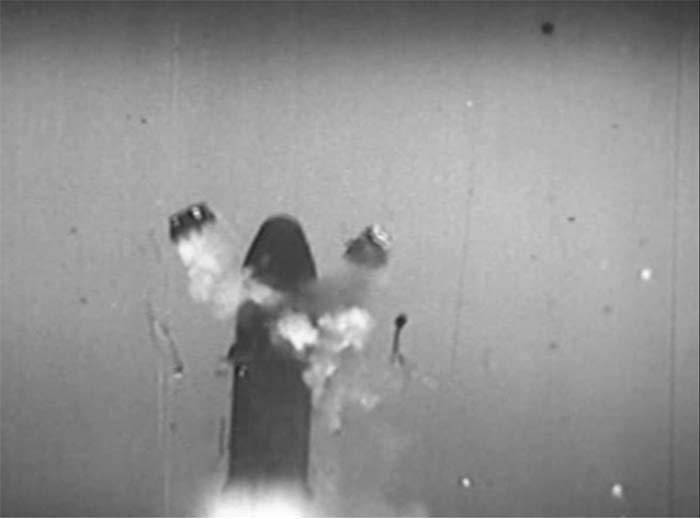
Rocket launch with the reset of external devices. Photo Militaryrussia.ru
After getting out of the water, the rocket had to turn on the engine of the first stage, as well as reset the device for forming a cavity and shock-absorbing belts. The active part of the flight began. After the production of fuel of the first stage, which required about one and a half minutes, its body was dropped and the engines of the second stage were turned on. In addition, at this moment, the lively head fairing was dropped, after which the head part of the product was formed by the conical case of the warhead.
After disconnecting the engines of the second stage and dumping the spent body, the stage of dilution, which is responsible for bringing the combat unit (or blocks) to the desired trajectory, should have entered the business.
In the D-11 / P-31 project, several new ideas were applied that required additional refinement. In 1974, a stand for throwing launches of a new weapon was built at the Rzhevsky range. This stand allowed to check the main features of the “cold” start of the product on the scale of 1: 4, after which it became possible to continue working on the main project. Also tests were carried out on full-size mock-ups, in which the PS-5M Balaclava submersible stand was used.
In addition, tests were carried out on individual elements of the missile complex, primarily the engines. According to reports, during the tests 40 bench checks of the first stage engine and 80 tests of the second engine were carried out. This stage of testing allowed to adjust the design of the engines and ensure the correct operation of serial products.
The first carrier of the new missile complex was to be the K-140 nuclear submarine of the 667 project. In 1972, this submarine was sent for modernization under the 667AM Navag-M project, which included the installation of new systems. In the course of the modernization, the launch shafts were dismantled from the boat, instead of which new ones were installed. At the same time, the number of missiles transported was reduced: 12 mine sites were equipped with new systems, and the remaining 4 coaming in a rugged hull received plugs. The use of launchers of greater length led to a change in the design of the superstructure, covering their upper part.
After upgrading, the K-140 boat was ready for testing. In December, 1976, the first time she received a new weapon and went with him to sea. December 21 held the first test launch of the P-31 rocket from the carrier. In the future, the crew of the K-140 completed another 26 launches. The flight tests continued until the middle of the 1979 year. In mid-September, the new complex received a positive conclusion from the command of the Northern Fleet, and a year later the D-11 complex with the P-31 rocket was put into service.
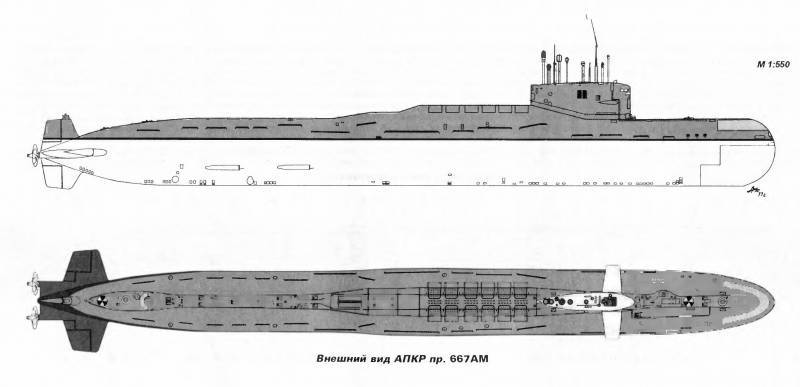
General view of the submarine pr. 667AM. Figure Apalkov Yu.V. "Submarines of the Soviet Navy 1945-1991. Volume II"
From the beginning of 1969, the specialists of TsKB-16 (later the Volna Central Design Bureau) worked on the project of a promising nuclear submarine of the 999 project, which was to become the carrier of the D-11 missile system. By 1973, it was planned to complete the design, and by the middle of the decade construction of the head submarine was to start. The prospective submarine was supposed to carry 16 launchers of the D-11 complex with the appropriate control equipment. However, in the 1973, the work ended. For administrative reasons, the 999 project was excluded from the Wave work plan for the next 74 year.
In connection with the closure of the 999 project and the lack of plans for the further modernization of the 667A project boats, the only carrier of the P-31 missiles was the submarine K-140. Such features of the operation of the new complex, in particular, have affected the production of missiles. After adopting the fleet received only 36 missiles of a new type. A number of these products were later used during combat training launches.
In 1990, the decision was made to terminate the operation of the D-11 complex with medium-range missiles P-31, which did not correspond to the new international agreements. According to reports, by this time the fleet had only 16 P-31 missiles. We decided to dispose of these products by running. From September to November several shots took place.
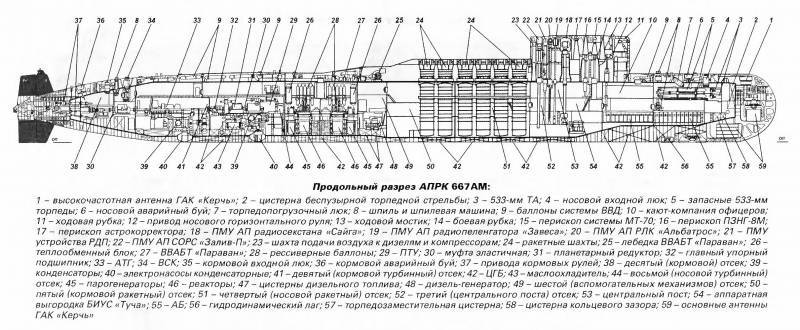
The structure of the submarine project 667AM. Figure Apalkov Yu.V. "Submarines of the Soviet Navy 1945-1991. Volume II"
During several sea exits, the K-140 crew was able to successfully launch 10 16 missiles. Shooting was carried out as a single launch, and a pair. The other six missiles for one reason or another did not start, including with some negative consequences for the design of launchers. After studying and servicing six unused missiles were reloaded into the mines of the carrier. Two products this time completed the task. The remaining four missiles had to be disposed of ashore.
By the beginning of the shooting of the remaining missiles, the K-140 submarine was withdrawn from the fleet. This status was maintained until 1997, when the crew was disbanded, and the cruiser went for recycling due to the lack of weapons and the impossibility of upgrading to new projects.
The D-11 complex with the P-31 rocket was not widely used and was only used on a submarine rebuilt to participate in the trials. Nevertheless, it was the first domestic complex with a solid-fuel rocket, which was successfully tested and adopted for service. The development of rocket technology and the use of accumulated experience allowed by the end of the seventies to create and bring to practical operation a new-class rocket complex. Work on the promising direction, which started in the late fifties, eventually led to the expected results.
Based on:
http://bastion-karpenko.ru/
http://armsdata.net/
http://militaryrussia.ru/blog/topic-408.html
Shirokorad A.B. Weapons of the domestic fleet. 1945-2000. - Minsk: “Harvest”, 2001
Apalkov Yu.V. Submarines of the Soviet Navy 1945-1991 Volume II: - M: Morkniga, 2011
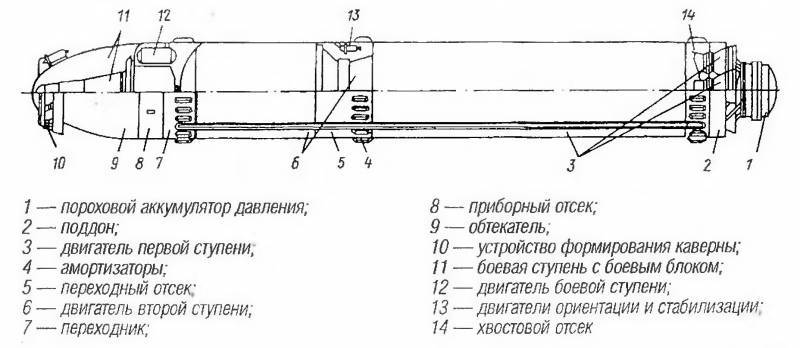
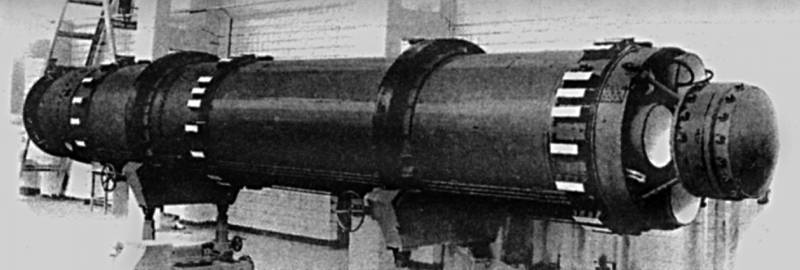
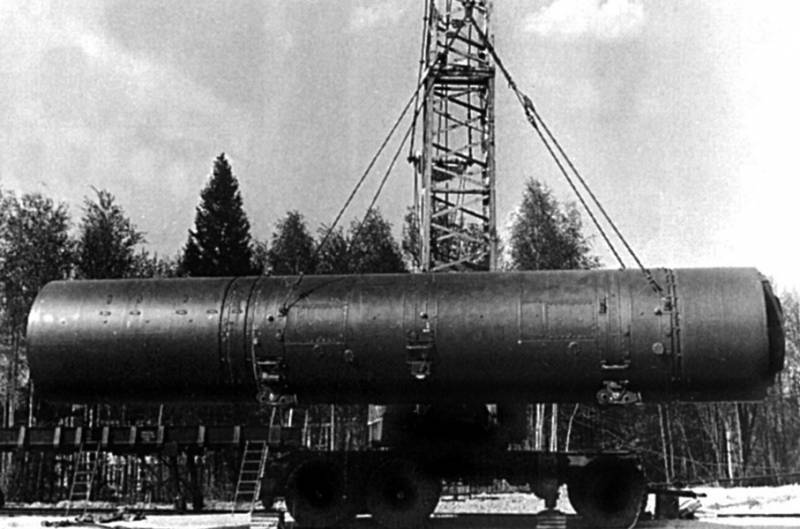
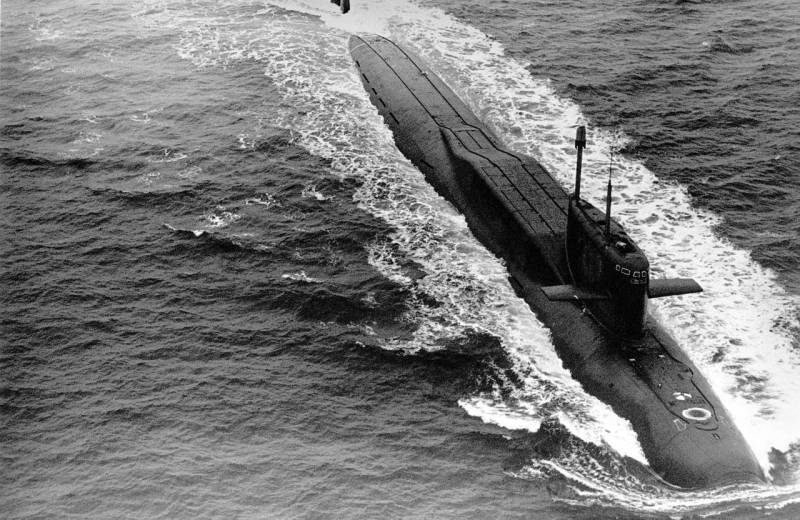
Information